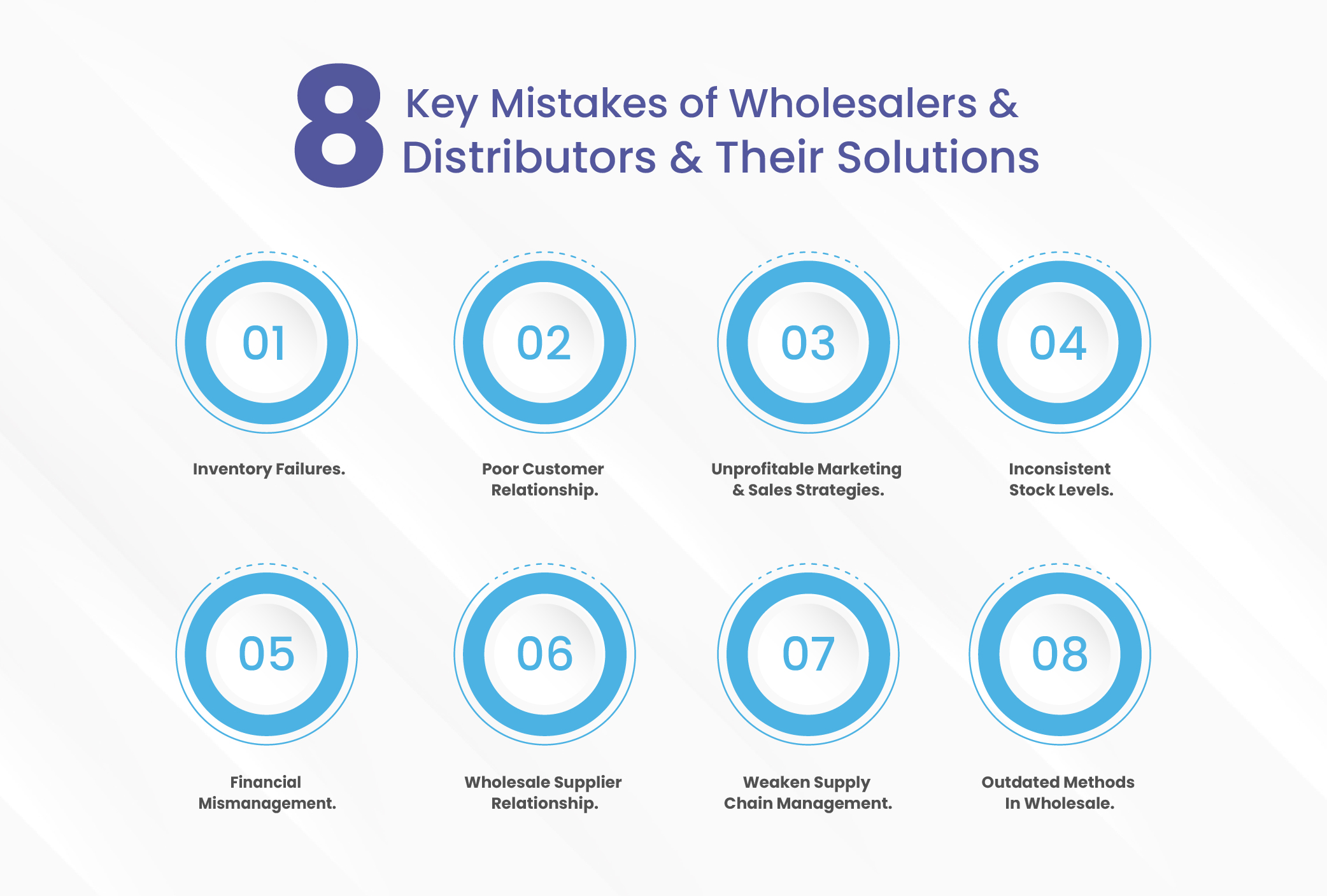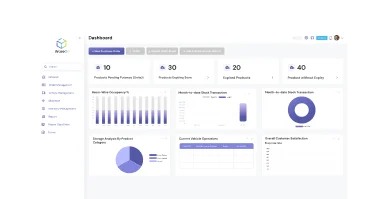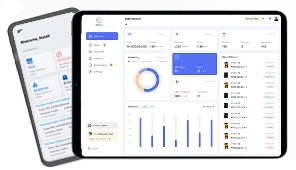
Wholesalers and distributors face a range of challenges in their operations, which impact their success and growth.
With e-commerce & DTC models gaining attention, wholesalers and distributors are facing significant pressure. This leads to common mistakes wholesalers & distributors make under pressure.
If you are already operating on razor-thin margins, a minor mistake can lead to significant financial setbacks.
However, to stay competitive, all your operations must be accurate, fast, and technology-enabled.
Tools, such as wholesale inventory management software, are designed to save you and your business money and streamline the process for increased profits.
58% of wholesale companies identified inventory management as their biggest challenge, and most of the mistakes occur within inventory management itself.
In this blog, we will examine the most common mistakes made by wholesalers and distributors and discuss how to avoid them to run a business effectively.
Let WareGo handle all the mistakes & make it right.
Book a Free Demo Now!Table of Contents
8 Key Mistakes of Wholesalers & Distributors With Their Solutions
Wholesalers and distributors play a vital role in driving a successful business. However, even a slight carelessness can turn a whole point around into unexpected consequences.
Some common and seemingly unimportant mistakes can become a crucial factor in negatively affecting the business and bringing it down.

Let’s discuss eight common mistakes that wholesalers or distributors inadvertently make, which can result in unintentional losses for them.
1. Inventory Failures
Poor inventory management leads to failures of effective wholesale inventory management software.
Managing inventories remains a significant challenge for many wholesalers due to the overburdened burden of stocks and products they handle.
Other than that, some common errors in inventory failure can include fluctuations in customer demand and unpredictable factors.
The leading cause of Inefficient Inventory Failures is:
- Overstocking of products.
- Understocking of inventories.
- Inefficient tracking.
Solution:
- Investing in a good inventory management system software, such as WareGo, which is one of the top software solutions.
- Automated reordering to record and find reorder points whenever stock levels are affected.
- Track real-time inventory and visibility to monitor inventory across various WMS locations.
2. Poor Customer Relationship Management
Don’t only focus on selling, but also try creating a healthier relationship with customers, which is an integral part for wholesalers.
Satisfying clients and meeting their expectations is a core part of our business growth, and for that, ensuring strong customer management is essential to safeguard your workflow.
What makes customers go away?
- No importance is placed on them, and they are often neglected in the provision of good customer service.
- Inconsistent treatment and inequality with clients. Do not erode their trust.
- Failing to communicate or not staying connected can lead them to easily forget you.
Solution:
- Act reasonably with all customers in all respects.
- Stay in touch and communicate with them.
- Keep them informed and engaged through regular emails or broadcasts.
3. Unprofitable Marketing & Sales Strategies
Wholesalers need to understand that increased reach doesn’t necessarily translate to increased revenue.
They need to align actual buyers and develop a sales strategy to attract them for profit. Ignoring Market Trends is also a primary factor of low ROI and wasted market spend.
How can it go wrong?
- Failing to recognize your target audience.
- Not enough attention is paid to online presence.
- No marketing strategies, just fitting the same planning in all approaches.
Solution:
- Use data segmentation techniques for marketing.
- Implement different trend strategies to stay engaged.
- Train your team to follow “Value selling,” not just volume selling.
4. Inconsistent Stock Levels
A shocking number of wholesalers and distributors still use manual spreadsheet systems to track inventories, resulting in inconsistent stock levels.
Keeping a record of a high volume of orders with multiple buyers is a daily struggle. You need clearer visibility about the items entering & exiting your warehouse. If not this, you won’t be able to update customers.
More mistakes include:
- Selling items that are not available.
- No proper record of the available goods.
- Delays in re-ordering.
Solution:
- Invest in a reliable inventory management system software.
- Opt for real-time visibility over your inventory.
- Eliminate manual records and human control.
5. Financial Mismanagement
Financial mismanagement is a silent killer in your business growth journey. It will not initially affect anything, but will come like a big wave of loss and disarray in business.
If you are not closely monitoring budgeting and cost flows, you are setting yourself up for a string of losses, which will not be beneficial to you.
Common errors distributors will face:
- Failing to control initial cost results in wasting resources and straining early business progress.
- Inadequate cash flows and mismanagement are bringing a shortage in sustainability.
- Ineffective cash budgeting can lead to overspending and erode the profit margin.
Solution:
- Conduct monthly cash flow reviews & quarterly/annual assessments of budget.
- Link your tools with wholesale inventory management software to connect budgets with inventory movement.
- Set up alert alarms to notify you in case of overspending or a low account balance.
WareGo can help you optimize your budget with software for improved financial management.
Try WareGo Now!6. Wholesale Supplier Relationship
Sourcing products from suppliers shouldn’t be the only focus for a wholesaler or distributor. Building a strategic relationship is also crucial for ongoing fulfillment. Relationships are necessary, especially in B2B arrangements where we deal.
2025 research by Naw Research confirmed that 45% of order fulfillment delays occur because of supplier & wholesaler issues. Trust, communication, and & reliability in each other are key to success.
Reasons for Weak Relationship:
- Underestimating the relationship with suppliers.
- Lack of transparency with a communication gap.
- Not monitoring suppliers’ performances through their products.
Solution:
- Use warehouse management software tools for vendor updates.
- Implement KPIs for all suppliers.
- Schedule a monthly meeting with them to facilitate better communication and coordination.
7. Weaken Supply Chain Management
A weak supply chain can be the biggest challenge for a wholesaler in this industry, where businesses are scaling across multiple vendors.
For timely fulfillment, customer satisfaction, and profitability, a well-maintained supply chain system is crucial. 65% of wholesalers lack real-time visibility in their supply chain, which is costing their business.
What is affecting this?
- Poor relationships are causing an inconsistent supply of goods, which in turn impacts the quality and availability of these goods.
- Lack of proper transportation or delivery processes leads to delays, increased costs, and negative customer reviews.
- Absence of transparency in the supply chain creates unforeseen disruptions for distributors.
Solution:
- Install Cross-Docking for faster turnover.
- Automate reordering points
- Invest in WMS integrations (ERP, E-commerce).
8. Outdated Methods in Wholesale
It’s surprising but true that industries are still relying on manual approaches to maintain their businesses, which is causing us liability. Storing manual data is nothing more than a headache to keep. Plus, it’s not a very convenient option while running a business.
Outdated methods are time-consuming, expensive, and increase the chances of errors in work. Disturbers have to face numerous challenges as the business grows; they simply can’t keep up with all the manual work.
Issues faced:
- Relying on antiquated manual systems for order processing & inventory management.
- Not looking through cloud-based solutions like ERP systems to hinder scalability.
- Missing automation opportunities leading to higher operational costs.
Solution:
- Use a cloud-based inventory management system software solution.
- Start automation with workflows like invoice generation & return handling.
- Implement logistic tools in your WMS.
Avoid Mistakes & Aim for Opportunities with WareGo
It’s your time to turn your mistakes into opportunities, and WareGo is here to help you do so. Common mistakes wholesalers and distributors make are sometimes overlooked or may seem small at first, but can create significant issues later on.
Avoid these mistakes before you fail to upgrade your systems or lose customer relationships. These mistakes prevent growth & adaptability in today’s competitive market.
Through research, it is clear that wholesalers and distributors who work on correcting their mistakes can increase customer retention by 62% after implementing digital initiatives.
WareGo's innovative inventory management system software is there to transform your mistakes into profits!
Contact Our Experts Now!Frequently Asked Questions
How do distributors differ from wholesalers?
Wholesalers and distributors both play a vital role in the supply chain. Their core responsibilities change when it comes to manufacturers.
Wholesalers typically:
- Purchase products in bulk from manufacturers.
- They resell the purchase products to retailers at volume and price.
While distributors typically:
- They are official representatives of a manufacturer.
- They handle sales and promotions, as well as services such as warehousing and customer support.
What are the biggest challenges you face in the wholesale distribution of electrical parts?
The five most significant challenges you can face are:
- Misarrangement of inventories.
- Wholesale Supplier Relationship.
- Poor Customer Relationship Management.
- Unprofitable Marketing & Sales Strategies
- Outdated Methods in Wholesale.
What are the disadvantages of having a wholesaler in the channel of distribution?
The most common disadvantages of a wholesaler in the channel of distribution can be:
- Low profit margins.
- Long distribution chains are delaying end-user delivery.
- Reduction of control over customers and branding.





